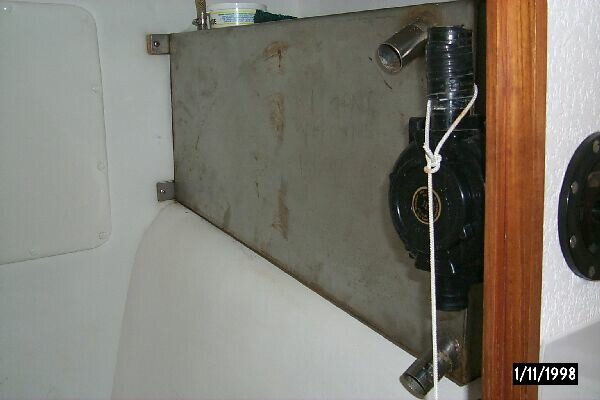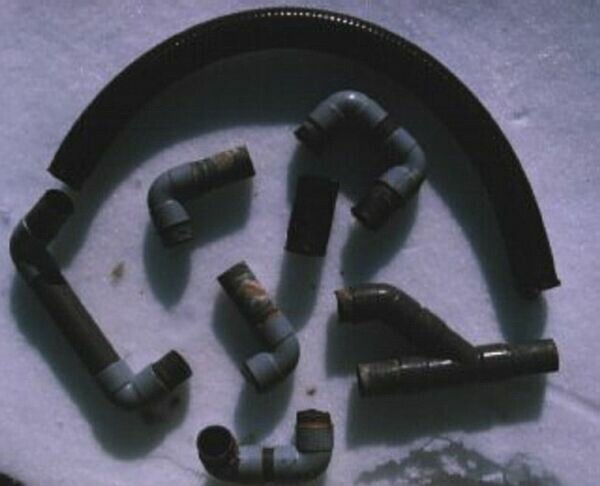Entering the Outhouse...
This project started simply as a hose replacement. Our head had always been smelly and since Prout Catamarans was of no help (they had been notified within a month of us taking possession of the boat but decided that, as usual, it would be our problem) I did some research on my own. The most likely source was hose permeation. As I understand it, what makes human waste especially smelly are the byproducts of anaerobic bacteria feasting on it. Anaerobic bacteria thrive in oxygen deprived environments such as hoses with standing water in them. This is the reason that holding tanks are supposed to have large ventilation hoses - it encourages aerobic bacteria growth (which don't produce smells).
Prout Catamarans decided to mount our holding tank in the compartment forward of the bathroom. Mounting the tank 6 feet from the toilet required a lot of hose - so smells due to hose permeation were expected, particularly given the quality of the hoses installed in our Escale catamaran. Thus, we decided to replace all the hoses in our system with high quality hoses which have a much higher resistance to permeation. You can test for permeation by placing a warm, wet rag on the hose and see if it smells. Ours did, hence the decision to replace the hose that Prout Catamarans had installed.
But as we pulled hose off the pump, the tanks, etc. it quickly became clear that we had a much bigger project on our hands than we originally anticipated.

Here is the holding tank with all the hoses removed. In front of it you can see the second bulkhead of the boat with the diaphragm pump that empties out the holding tank when we are offshore. On the plus side, the holding tank is self draining but the placement of the tank puts up to 25 gallons of weight in the bow and high up, which is not desirable.
Note the lack of barbs on the holding tank hose nipples. And while stainless tanks look nice, other materials have better performance. Unfortunately, uric acid and other sewage related corrosive by-products eat away at stainless seams - only certain, thick plastics will retain the sewage indefinitely. In particular, hard PVC sewage piping is permeation proof - too bad it isn't very flexible and would require a very careful installation.
Incidentally, boatbuilding.com has an excellent, in-depth lead article on the do's and don'ts of sanitation systems that illustrated just how unqualified Prout Catamarans was regarding the installation of our sewage system. In 1992, holding tanks must have been a novelty for them. For example, in order to minimize odor permeation, hose runs should be short, without dips, without kinks, and "downhill". Prout elected to install the holding tank 4 feet above the head, 6 feet away. Over 20 feet of 1 ½" diameter hose is required for the system as installed: Eight household sub-schedule 20 grade ABS elbow fittings were used in an effort to save money. The only highlight of our sewage system as installed were the high quality stainless hose clamps.

Here is a picture of some OEM hose and fittings. Since the old system was very convoluted, the installers opted to use a huge number of ABS fittings here and there to route hose around tight corners. As you can see, none of these "fittings" had hose barbs to properly interface with hose. The brown stains along the entire length of those pipes attests to the depth that the sewage penetrated. Also note how many sections of pipe had broken off when we tried to remove them. Only a few hose interfaces remain, most of them are still stuck inside their hoses.
In other words, we had just discovered that permeation wasn't our only problem. Thus, it might be a good idea to have a closer look at the plumbing in your Prout Catamaran. Not convinced yet? Just see what can of worms we opened next.
Best Estimate of Time Required:
| Research holding tanks, sanitation system best practices, diagram system | 8 hours |
|---|---|
| Order new hoses, parts | 0.5 hours |
| Remove OEM hoses, connections | 0.5 hours |
| Total | 9 hours |
|---|

